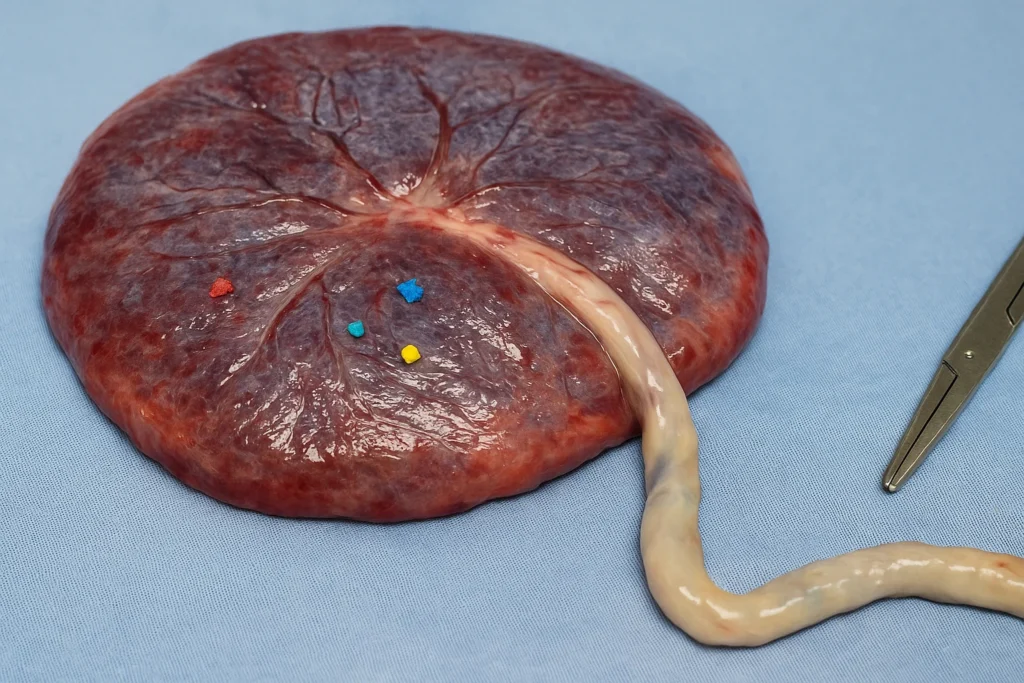A Groundbreaking Discovery That Rewrote Medical Textbooks
In a nondescript laboratory at the University of New Mexico’s Health Sciences Center, a team of researchers led by Dr. Matthew Campen made a discovery so profound it would fundamentally alter our understanding of human biology. While analyzing placental tissue samples using state-of-the-art Raman microscopy, they detected something that should have been impossible – microscopic plastic particles embedded deep within the protective barrier that nurtures developing fetuses.
The initial reaction was disbelief. “We thought our equipment must be contaminated,” recalls Dr. Campen. “We ran the tests again and again, using different methodologies, but the results kept coming back the same.” Their 2024 study, published in the prestigious journal Toxicological Sciences, would reveal that all 62 placental samples tested contained measurable quantities of microplastics, with some showing concentrations as high as 790 micrograms per gram of tissue.
This finding sent shockwaves through the scientific community, forcing a dramatic reconsideration of what we know about fetal protection and environmental exposure. The placenta, long considered nature’s most sophisticated filtration system, had been breached by a man-made contaminant that didn’t exist a century ago.
Understanding the Microscopic Invaders
What Exactly Are Microplastics?
Microplastics are defined as plastic particles smaller than 5mm in diameter (about the size of a sesame seed), while nanoplastics are even smaller – typically less than 1 micrometer (about 1/70th the width of a human hair). These particles originate from two primary sources:
- Primary Microplastics:
- Intentionally manufactured tiny plastic beads used in personal care products like facial scrubs and toothpaste
- Industrial abrasives used for cleaning and polishing
- Synthetic textile fibers released during laundry
- Secondary Microplastics:
- Fragments from the breakdown of larger plastic items like water bottles and food packaging
- Degraded fishing nets and other marine debris
- Tire wear particles from vehicles
Unlike organic materials that biodegrade, plastics simply break down into smaller and smaller pieces, persisting in the environment indefinitely and accumulating in living organisms.
The Shocking Prevalence in Our World
Recent studies have revealed the staggering ubiquity of microplastic contamination:
In Our Environment:
- 94% of U.S. tap water samples contain detectable microplastics
- 90% of commercial table salt brands tested worldwide show contamination
- 100% of marine water samples from the Arctic to Antarctica contain plastic particles
In Our Bodies:
- The average person now ingests approximately 5 grams of plastic per week – equivalent to a credit card’s worth
- Microplastics have been found in human blood, lungs, liver, and now placentas
- Recent studies detected plastic particles in breast milk samples from 75% of tested mothers across multiple continents
The Journey From Environment to Womb: How Plastic Invades the Most Protected Space
The placental barrier is evolution’s masterpiece – a highly selective membrane that allows nutrients and oxygen to pass to the fetus while blocking harmful substances. That microplastics can penetrate this defense system represents a profound biological failure with potentially far-reaching consequences.
Multiple Pathways of Invasion
- Respiratory Absorption
- Indoor air contains thousands of microplastic particles per cubic meter, primarily from synthetic fabrics and household dust
- Urban environments show particularly high concentrations due to tire wear and industrial emissions
- Particles smaller than 10 micrometers can cross from the lungs into the bloodstream
- Gastrointestinal Uptake
- Bottled water contains significantly higher microplastic concentrations than tap water
- Seafood, especially filter feeders like mussels and oysters, accumulate high plastic loads
- Food packaging sheds microscopic particles into meals, especially when heated
- Dermal Penetration
- Many personal care products still contain plastic microbeads despite growing restrictions
- Synthetic clothing releases fibers that can absorb through skin, especially during activities that cause sweating
- Some medical products and cosmetics contain plastic nanoparticles designed for enhanced delivery
The Biological Odyssey
Once inside the maternal body, microplastics embark on a concerning journey:
- Cellular Entry: Nanoparticles smaller than 0.1 micrometers can passively diffuse through cell membranes
- Systemic Circulation: Particles enter the bloodstream and lymphatic system, becoming distributed throughout the body
- Organ Accumulation: Some plastics accumulate in fatty tissues or organs like the liver
- Placental Crossing: Particles penetrate the placental barrier through:
- Passive diffusion of nanoparticles
- Cellular transport mechanisms
- Disruption of tight junctions between placental cells
Potential Health Impacts: A Looming Intergenerational Crisis
What Animal Studies Reveal
Controlled experiments on mammals have demonstrated several alarming effects from prenatal plastic exposure:
- Growth Restriction: Exposed rodent fetuses showed significantly lower birth weights
- Neurological Changes: Altered behavior patterns suggesting cognitive impacts
- Metabolic Disruption: Increased predisposition to obesity and insulin resistance in adulthood
- Multi-Generational Effects: Changes persisting in offspring despite no direct exposure
Emerging Human Correlations
While human studies are still in early stages, several concerning patterns have emerged:
- Preterm Birth Risk: Placentas from premature births showed higher plastic concentrations
- Developmental Disorders: Some researchers hypothesize links to rising rates of conditions like ADHD and autism
- Endocrine Disruption: Many plastic additives are known to interfere with hormone function
Three Critical Areas of Concern
- Immune System Programming
- Microplastics may trigger inappropriate immune responses
- Potential connection to rising autoimmune conditions in children
- Possible disruption of normal immune tolerance development
- Neurological Development
- Plastic additives like phthalates are established neurotoxins
- Potential interference with crucial stages of brain formation
- Possible epigenetic changes affecting cognitive function
- Metabolic Set Points
- Early exposure may permanently alter metabolic regulation
- Could explain rising rates of childhood obesity and diabetes
- Potential for transgenerational metabolic effects
Geographic and Socioeconomic Disparities in Exposure
High-Risk Populations
Urban Centers
- New York City placentas showed double the microplastic load of rural samples
- Proximity to heavy traffic correlates with higher exposure to tire particles
- Dense populations generate more plastic waste and airborne particles
Coastal Communities
- Higher seafood consumption increases exposure to marine microplastics
- Fishing industry contributes substantial microfiber pollution
- Ocean currents concentrate plastics in certain coastal areas
Developing Nations
- Limited waste management infrastructure leads to more environmental plastic
- Common practice of open plastic burning creates airborne nanoparticles
- Fewer alternatives to plastic-packaged foods and goods
The Environmental Justice Dimension
Marginalized communities face compounded risks:
- Proximity Hazards: Many low-income neighborhoods are located near plastic production facilities
- Limited Options: Fewer resources to purchase plastic-free alternatives
- Healthcare Gaps: Less access to advanced prenatal monitoring and care
- Food Deserts: Greater reliance on heavily packaged processed foods
The Global Scientific Response
Major Research Initiatives
The PLACENTA Project (European Union)
- Tracking 1,000 mother-baby pairs across 10 countries
- Correlating plastic exposure levels with developmental outcomes
- Incorporating advanced imaging to assess potential organ impacts
NIH Longitudinal Study (United States)
- Following children from birth through adolescence
- Comprehensive neurological and metabolic testing at key developmental stages
- Using machine learning to identify subtle exposure-effect relationships
Global Biobank Initiative
- Collecting and analyzing placental samples from 50 nations
- Creating the first worldwide microplastic contamination map
- Identifying regional risk factors and exposure pathways
Technical Challenges in Research
Scientists face significant hurdles:
- Detection Limitations: Current methods struggle with smallest nanoparticles
- Control Group Dilemma: Finding unexposed populations is increasingly difficult
- Complex Interactions: Disentangling plastic effects from other environmental toxins
- Long-Term Tracking: Understanding lifelong impacts requires decades of study
Solutions in Progress: From Policy to Personal Action
International Policy Responses
United Nations Global Plastic Treaty
- First international agreement specifically targeting plastic pollution
- Addresses production, waste management, and environmental monitoring
- Includes provisions for research funding and technology transfer
European Union Regulations
- Comprehensive ban on intentionally added microplastics effective 2025
- Strict new requirements for plastic product labeling
- Extended producer responsibility laws
National Actions
- Canada’s single-use plastic ban covering checkout bags, cutlery, and foodware
- Rwanda’s pioneering plastic-free initiatives achieving 90% reduction
- Australia’s investment in next-generation recycling technologies
Technological Innovations
Advanced Filtration Systems
- Nanofiber membranes capable of removing 99.9% of microplastics
- Magnetic separation techniques for water treatment plants
- Bio-inspired filters mimicking natural filtration systems
Sustainable Materials
- Algae-based bioplastics that fully degrade in marine environments
- Mycelium packaging grown from mushroom roots
- Self-destructing polymers designed for controlled lifespan
What Individuals Can Do
Reducing Exposure
- Choose glass or stainless steel food containers over plastic
- Install certified microplastic water filtration systems
- Select fresh, unpackaged foods whenever possible
- Avoid heating food in plastic containers
Supporting Systemic Change
- Advocate for strong plastic reduction policies
- Support businesses investing in sustainable alternatives
- Participate in citizen science monitoring programs
- Educate communities about plastic-free living strategies
Voices From the Frontlines
The Researchers
“This isn’t just an environmental issue – it’s redefining human biology in real time. We’re seeing the first generation where plastic exposure begins before birth.”
- Dr. Sarah Dunlop, Plastics Research Lead
The Parents
“When I learned my placenta contained plastic particles, it changed everything. Now I see plastic not as convenience, but as contamination.”
- Jamal Reynolds, Study Participant
The Activists
“The placenta findings prove we can’t keep treating plastic as someone else’s problem. It’s in all of us now – literally.”
- Araya Jensen, Environmental Health Coalition
The Path Forward: Challenges and Opportunities
Critical Knowledge Gaps
- Establishing safe exposure thresholds (if any exist)
- Understanding long-term health consequences across the lifespan
- Developing effective methods for removing microplastics from the body
- Assessing combined effects with other environmental stressors
Ethical Considerations
- Right-to-know laws about personal exposure levels
- Environmental justice in policy responses
- Balancing urgent concern with actionable solutions
- Assigning responsibility across industries and governments
Reasons for Hope
- Rapid advances in detection and filtration technologies
- Growing public awareness driving demand for change
- Increasing corporate investment in sustainable alternatives
- Global scientific collaboration accelerating solutions
As Dr. Campen reflects on his team’s discovery: “We’ve crossed a threshold we can’t uncross. But every crisis contains opportunity – this is our chance to reimagine humanity’s relationship with materials, and ultimately, with ourselves.”
The story of microplastics in placentas represents more than an environmental health crisis – it’s a fundamental question about the future we’re creating. In this plastic age, we’re all participants in an unprecedented biological experiment. The choices we make today will echo through generations yet unborn.




4slt9p
2z5f66
h4x86u